
Cheuk Hei Ho writes a detailed analysis of Roma and their tactics in the 2016-17 season.
Roma have finished second place in Serie A, behind Juventus. Having crashed out of Coppa Italia and the Europa League as well, Roma will endure another trophy-less season, a disappointment for a team stacked with top talents in every position. What went wrong? Is Roma the gladiator that its fans hope for, or the choker that its critics believe?
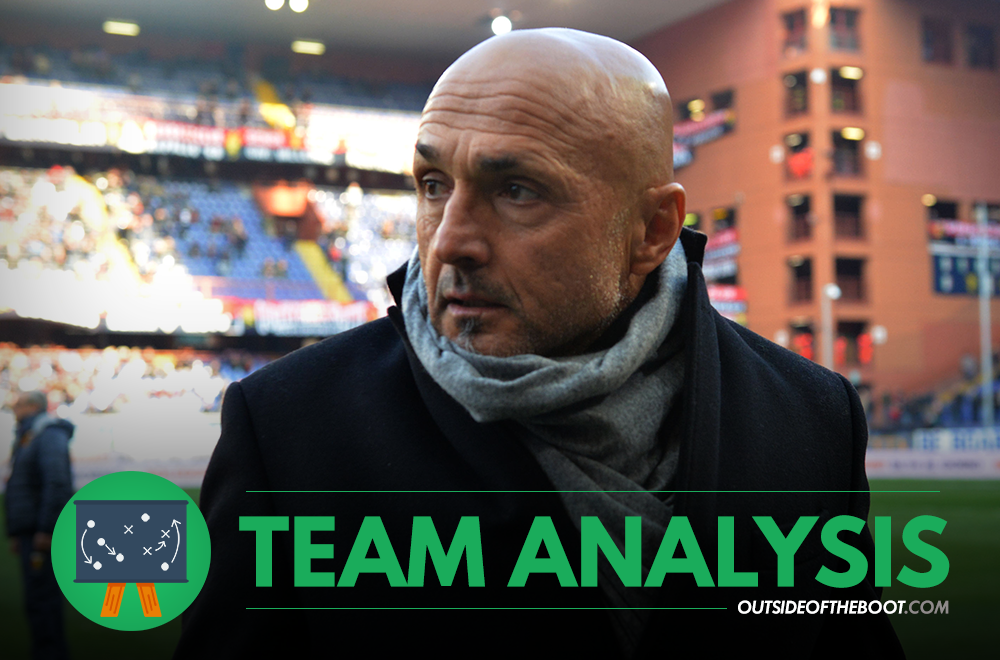
How do they play?
Luciano Spalletti is a tactical wizard who is not afraid to invent and experiment. This season, Spalletti has used multiple lineups and formations against different opponents. In particularly, Wojciech Szczesny is the starting keeper. He is mostly protected by a four-man defense starting with Emerson on the left, Kostas Manolas and Federico Fazio in the middle and Antonio Rudiger on the right. In the midfield, captain Daniele De Rossi anchors the midfield and is supported by Kevin Strootman and Radja Nainggolan. At the front, Diego Perotti and Mohamed Salah support Serie A’s leading scorer Edin Dzeko. In this case, Roma uses a 4-3-3 formation.

Made using TacticalPad
But characterizing Roma into one particular shape is over-simplifying its tactics because Roma uses multiple forms even during different phases of a match. For example, when using the above lineup, Roma uses a back three during the initial buildup, with Rudiger moving centrally to join Manolas and Fazio:
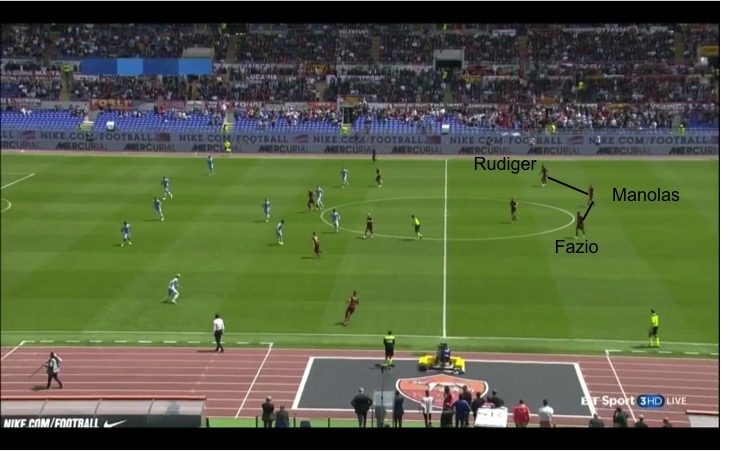
Emerson will move up and take the left midfielder role while Nainggolan becomes the wide midfielder on the right side or Salah may drop backward as the right winger. In some ways, Nainggolan covers such a wide area that his position becomes irrelevant no matter where you put him. In these cases, Roma resembles a 3-4-3 or a 3-5-2. The back three allows Roma to control the center in the offensive phase better while the return to the back four allows better coverage of the field during the defensive phase.
The transition between 4-3-3 and 3-4-3 or 3-5-2 is Spaletti’s most used team shape change. With different players, he also creates different characteristics for the team. For example, one of the most extreme lineups Spaletti used this season is a back four of (from left to right) Juan Jesus, Manolas, Fazio, and Rudiger. Both Jesus and Rudiger have the skills to play as wing-backs. Therefore, either player can move up to take the advanced role to create a back three in the offensive phase, depending who is playing (Perotti, Emerson or Bruno Peres, a right wing-back). Defensively, the back four averages 6 feet 3 inches (average soccer player height is 5 feet, 11-1/2 inches) and is dominant aerially.
During his first stint at Roma, Spaletti implemented a modern false-nine system, playing a 4-6-0 formation without any striker. Totti was the center of his system. He interpreted the false-nine role perfectly and was surrounded by numerous midfield runners, who took advantage of the space left behind by Totti and his creativity. His tactic inspired many other coaches.
Much has changed in Roma since Spaletti’s return. Age has caught up. Totti is no longer the player he once was. Instead of a false-nine, Spaletti found a classic target man, a 6 feet and 4 inch tall striker in Dzeko. He did not force the new players to adopt his old tactic. Rather, he designed an entirely new system to maximize his players’ potential.
Roma’s build-up is simple. The center backs and De Rossi like to use long balls to find Dzeko, Salah or Nainngolan in the center, or the wing backs or wide midfielders on the flanks:
Roma averages 64 long passes a game, a modest number that only puts them ninth in Serie A. However, long passes are difficult to make, and Roma is exceptionally good at it. In fact, they average 38.7 accurate long passes a game with a 60.5% success rate, which ranks second and third in the league respectively. Roma’s high success rate of long passes is partly because of Roma’s aerial dominance. They lead the league by winning almost 60% of their headers. A more telling statistic about Roma’s long ball style is the % of key passes that are long passes per game:
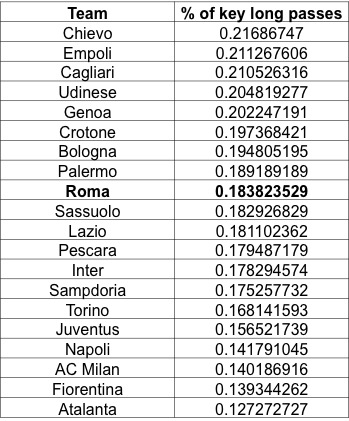
About 18.4% of Roma’s key passes are long passes. This number put them ninth in Serie A, a modest position. However, when looking carefully, none of the team with a higher % of key long passes sits higher than eleventh in the table. In comparison, Juventus, Napoli and Atalanta use much fewer long passes to create chances (ranked 16th, 17th and 20th in the league). Therefore, Roma’s style resembles the lesser teams, who often do not have the ability to consistently and gradually build up the offensive phase. They have to rely on the long passes to bypass the lines of defense. Such a style is completely opposed to the “organized chaos” that was so appealing to football lovers in Spaletti’s first Roma stint.
Roma can (and want to) play so many long passes because they have Salah and Dzeko. Salah is one of the fastest players in the world, who is believed to be able to finish running 100 meters in 10 seconds:
With Salah’s speed, Roma can always play a counter attack game without possession when necessary. For example, in their first meeting against Inter, Roma had only about 36% of possession but took an equal number of shots to Inter, and eventually won the game.
In contrast, Dzeko is one of the best headers in the world. This season in Serie A, he attempted 6.7 headers (6th among active strikers who play more than five games) and won 3.9 (1st among striker) headers per game. Aside from the headers, Dzeko is also very skillful and strong, making him an excellent target man. He is the primary target of Roma’s long overhead passes.
Roma often attacks the opponent by sending the long passes to Dzeko. He will then try to connect with Salah, Nanniggolan, Strootman who are always ready to run towards the penalty box or the wing-backs that are overlapping on the flanks.
With Salah’s speed, Dzeko can always create chances for him if he can direct the ball towards Salah’s direction during a counter attack when the opponent is exposed. Nanniggolan has the power and technique to create chances for himself or his teammates in tight spaces. This tactic is highly effective. Roma averages 17.7 shots and 2.2 goals per game, which rank 1st and 2nd in the league, respectively.
A typical Roma build-up looks like this:
Roma’s major weakness this season is its defense. On the surface, Roma’s defense does not perform badly. They concede 0.94 goals per game, second to Juventus’ 0.67 goals per game. However, Roma only concedes so few goals because of Szczęsny’s brilliant form. For example, looking beyond the number of goals, Roma concedes 12.7 shots conceded per game, a number that ranks only 7th in the league. This figure is relatively high considering that Roma averages 55.4% of the possession each game. When measuring the number of shot conceded per opponent’s possession, Roma ranks only 13th in the league, a very mediocre defensive performance for a team that has title aspirations. In fact, Roma is only better than Torino, Sassuolo, Chievo, Milan, Pescara, Cagliari and Empoli in this regard.
At least two factors contribute to Roma’s relatively poor performance in defense. Firstly, Roma’s front players do not have the discipline to maintain a cohesive line of defense consistently.
Whoever Roma is playing; there always comes a time when Dzeko, Salah, and Nainggolan do not apply pressure to the opponent, or they do not maintain a cohesive line or guard their zones. Worse, a few Roma players will try to press the opponents while the others watch. An uncoordinated press is worse than not pressing at all because there isn’t enough pressure on the opponent and the team’s defensive shape is broken. Therefore, the opponent only has to deal with less than two lines of defense. In particular, they can often penetrate Roma centrally without a lot of pressure, getting right in front of the box, with De Rossi the only player to protect the center back.
In these situations, De Rossi is often under a lot of pressure. He is often outnumbered. If he stays in his position, the opponent can unleash a shot right in front of the penalty box; If he comes out to tackle, he will leave the center backs exposed, who are already consumed by marking the opponents forwards.
Secondly, Roma’s reliance on the long passes requires the team to maximize the usage of the length and width of the pitch. The players often position in a typical way: The three center backs and De Rossi will position themselves in front of their box to advance the ball. The wing-backs stay close to the sidelines to stretch the opponent. De Rossi and the center backs will try to send long passes towards Dzeko, with Strootman, Salah, and Nainggolan ready to run towards the box to connect with Dzeko’s second passes. Therefore, centrally, Roma’s players are divided into two groups separated by a long distance. When Roma’s forward vertical passes from the back are cut off or intercepted, there will not be enough players close to the ball to challenge the opponent, exposing the last line of the defense.
Roma’s weaknesses in defense persisted throughout the season, and it is a major reason why they will endure another trophy-less season.
The key players
Wojciech Szczesny: Szczesny was one of the best Roma players this season. Heavily criticized for his inconsistent performances at Arsenal, Szczesny has since become a very consistent and reliable player at Roma, and his performance is underappreciated. This season, Roma conceded 32 goals (average 0.94 goals per game) in Serie A, a modest number compared to leaders Juventus (conceded only 23 goals). When measuring a keeper’s performance by comparing the number of goals conceded per number of shots, Szczesny is still second to Buffon but at a much closer distance:
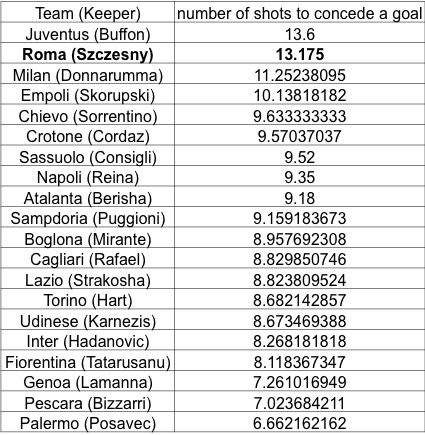
In fact, their numbers are almost indistinguishable: It took 13.6 shots to score a goal against Gianluigi Buffon while it took 0.5 less shot to score against Szcesny (3% difference). In comparison, it took only 11.3 shots to score against Gianluigi Donnarumma (17% difference). Therefore, Szczesny’s performance is similar to Buffon’s and not worse, and probably better than Donnarumma’s, who is often viewed as the best keeper of Serie A this season.
Antonio Rudiger: Both Fazio and Manolas have more shining moments for Roma this season, but Rudiger is critical for Spaletti’s tactics when the team shifts between a back three and back four. Without him (or Jesus, who plays a lot fewer minutes), Roma would not be able to achieve these changes.
Daniele De Rossi: He captains the team, and he also anchors the team during their initial offensive phase. As a central defensive midfielder, he is often the center back’s primary target if they are not able to send a long pass to Dzeko. De Rossi always positions himself so that the center backs’ passing lanes towards him remain open.
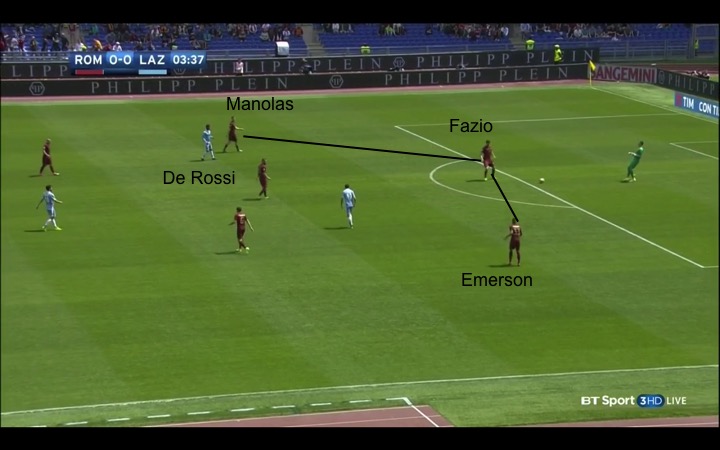
After receiving the ball, De Rossi will look to send vertical passes to penetrate the opponent’s first and second lines of defense.
De Rossi’s function in this regard is critical for Roma because Roma does not play a lot of passes between midfielders when they try to open the opponent’s first and second line of defense. He is responsible for sending vertical passes to the teammates in the front when they are not able to send long overhead passes to Dzeko or Salah. Moreover, he is the last player to protect the defenders when the opponent successfully penetrates their first lines of defense.
Radja Nainggolan: Nainggolan has become one of the best, if not the best box-to-box midfielder nowadays. This season alone, he scored ten goals in the league, almost double his tally from last season and the season before that, and almost equal to his ten years spent in Piacenza and Cagliari. Spaletti has deployed him as the most advanced midfielder this season, and Nainnggolan has flourished with his vision and technique:
Combining with his power and athleticism, Nainggolan is a formidable and dangerous creator and finisher for Roma.
Edin Dzeko: He is the leading Serie A scorer, having amassed 27 goals this season. In Roma, Dzeko is more than just a goal scorer. He is the center of Roma’s offense, very much like what Francesco Totti was for Roma during Spaletti’s first stint in Roma.
Where do they need to improve?
A team is considered a choker when it fails to win a game when it is the overwhelming favorite to win. This season, Roma was once again labeled as a choker when they lost to Porto (UCL qualifying game), Lyon (Europa League round of 16), and Lazio (Coppa Italia semi-final). Roma may be a favorite to win these matches, but there are some systematic weaknesses and issues that prevent them from dominating these other teams. Other than the second game against Porto at home, Roma’s players tried their best and fought hard in all other matches. At least for this season, Roma is not a choker but a gladiator, albeit a flawed one.
Spaletti has designed a tactic that maximizes the offensive potential of the team. He has largely cured Roma’s tendency to collapse in a pressured environment. However, after spending five years abroad, he still cannot install the discipline that a champion team needs. It is not a coincidence that Roma won its last Scudetto under Fabio Capello, the ultimate disciplinarian. Spaletti has always said that Roma lacks the mental quality of a champion, and it is an enigma to him why they fail to establish that mentality. Maybe the truth is that it is him who does not have the ability to install that mentality in this Roma team. Spalletti may be an innovative and creative tactician, but he has yet to show that he is a coach who can deliver a title at the highest level.
Read all our other team analyses here
























































